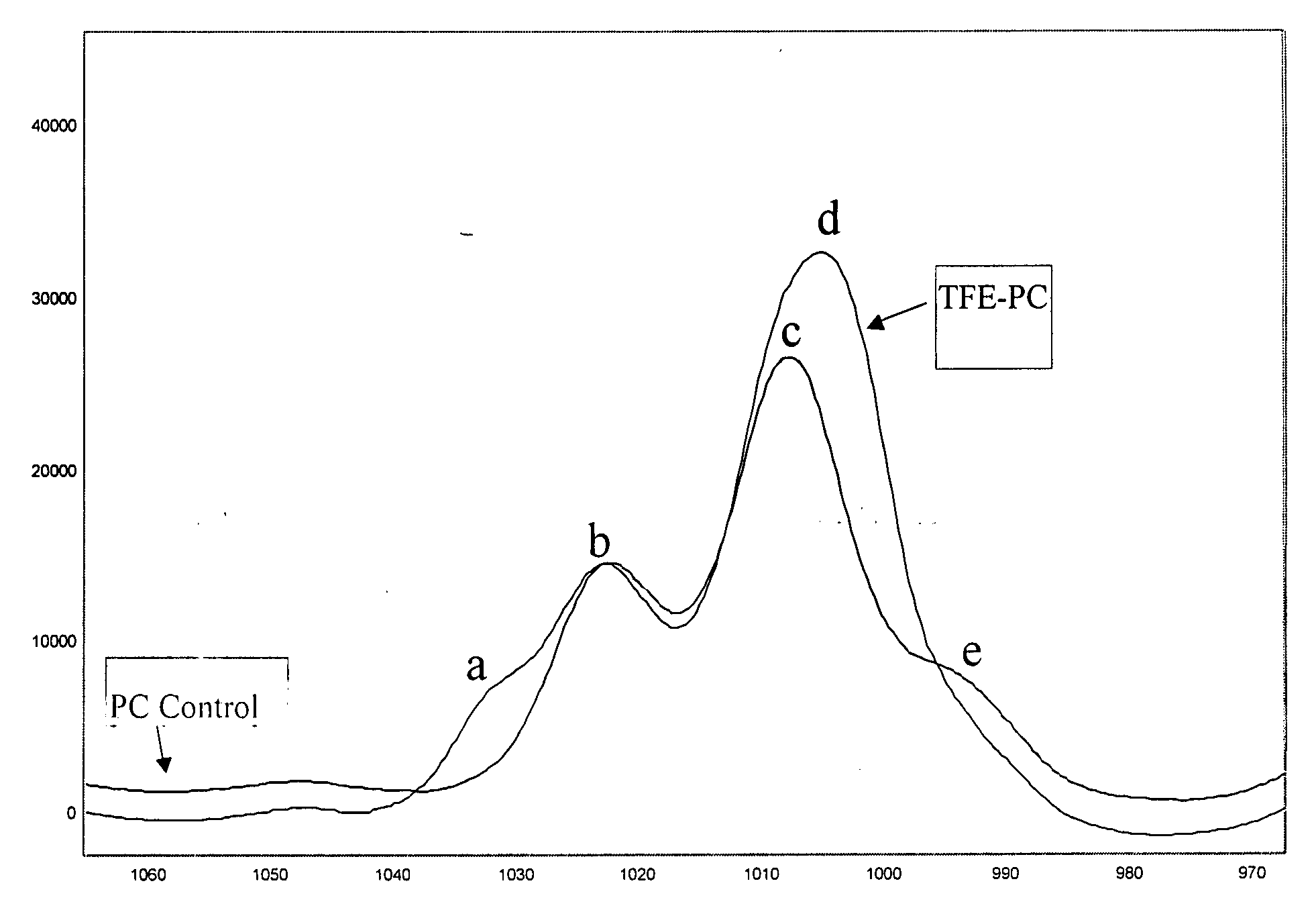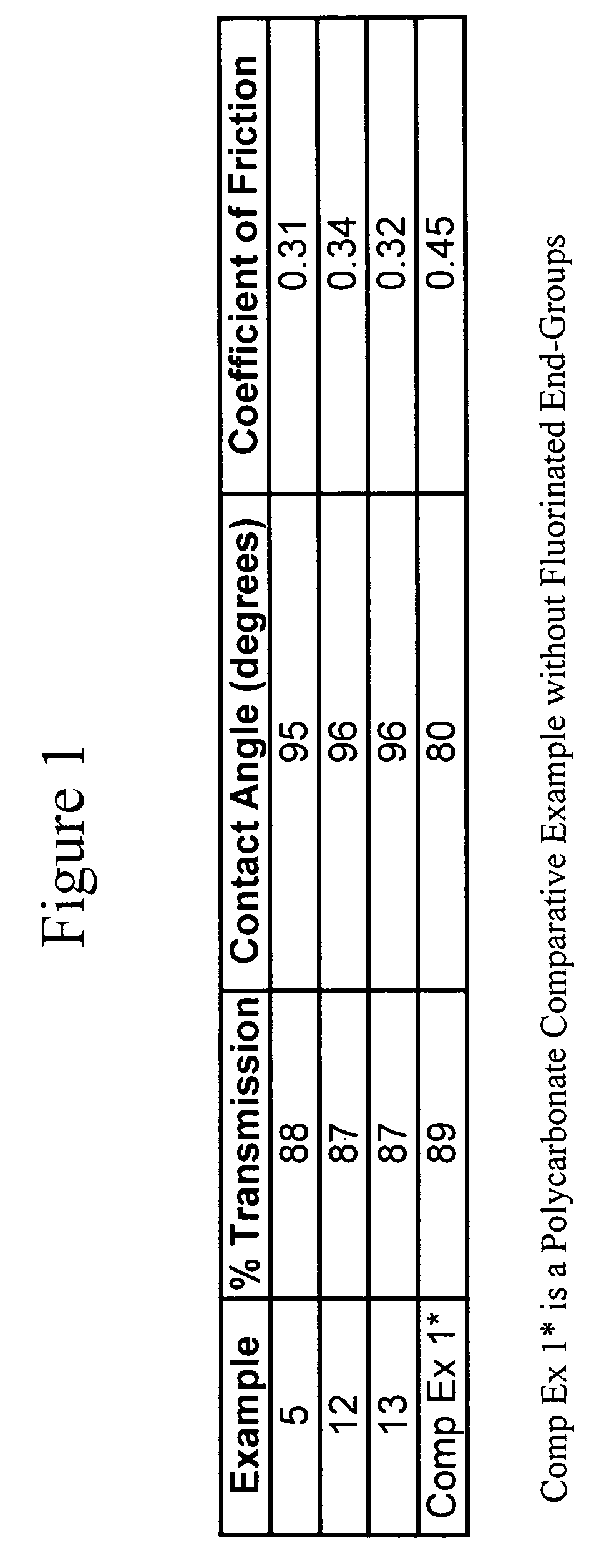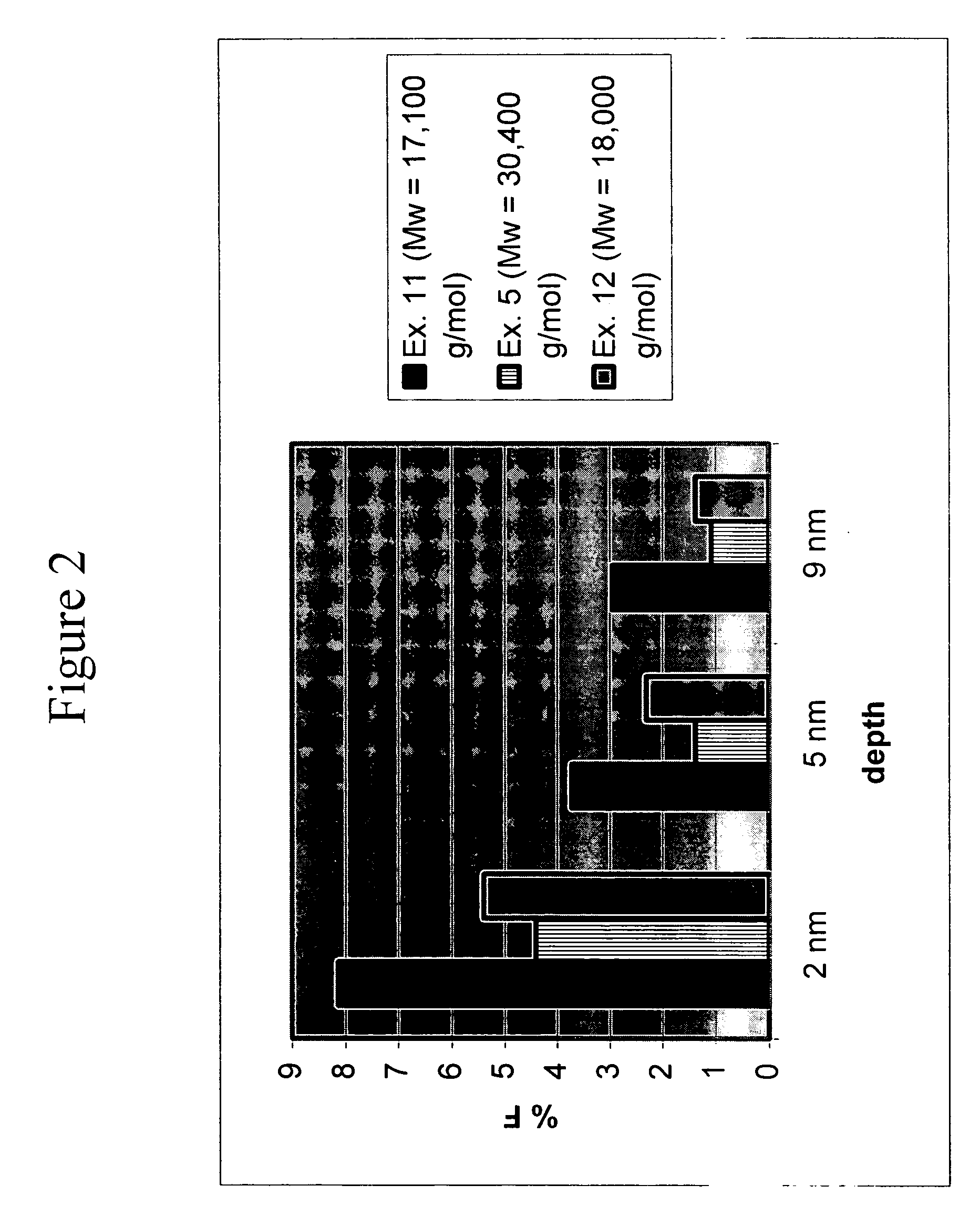Polycarbonates with fluoroalkylene carbonate end groups
a technology of fluoroalkylene carbonate and end-group structure, which is applied in the field of polycarbonate and copolycarbonate resins, can solve the problems of loss of desirable properties, degradation of surface quality of resultant molded articles, and tendency of many fluorinated end-group structures to undergo chemical or thermal reactions
- Summary
- Abstract
- Description
- Claims
- Application Information
AI Technical Summary
Benefits of technology
Problems solved by technology
Method used
Image
Examples
example 1
[0095] The following were added into a 500 mL 5-necked glass reactor: (a) BPA (25 g, 0.11 mol); (b) C9F17—OH (4.0 g, 0.0089 mol); (c) triethylamine (0.23 mL, 0.0016 mol); (d) methylene chloride (145 mL); and (e) de-ionized water (144 mL). The mixture was charged with phosgene (13.6 g, 0.75 g / min, 0.14 mol). During the addition of phosgene, base (25 wt. % NaOH in deionized water) was simultaneously charged to the reactor to maintain the pH of the reaction between 9 and 11. After the complete addition of phosgene, the reaction was purged with nitrogen gas, and the organic layer was extracted. The organic extract was washed once with dilute hydrochloric acid (HCl), and subsequently washed with de-ionized water three times. The organic layer was separated and precipitated into vigorously stirred hot water. The polymer was dried in an oven at 110° C. before analysis. 19F and 1H NMR confirmed quantitative conversion of C9F17—OH into C9F17-carbonate polymer chain end groups. Surface analys...
example 2
[0096] The following were added into a 500 mL 5-necked glass reactor: (a) BPA (25 g, 0.11 mol); (b) TFE-OH (0.9 g, 0.009 mol); (c) triethylamine (0.23 mL, 0.0016 mol); (d) methylene chloride (210 mL); and (e) de-ionized water (140 mL). The mixture was charged with phosgene (13.6 g, 0.75 g / min, 0.14 mol). During the addition of phosgene, base (25 wt. % NaOH in deionized water) was simultaneously charged to the reactor to maintain the pH of the reaction between 9 and 11. After the complete addition of phosgene, the reaction was purged with nitrogen gas, and the organic layer was extracted. The organic extract was washed once with dilute hydrochloric acid (HCl), and subsequently washed with de-ionized water three times. The organic layer was separated and precipitated into vigorously stirred hot water. The polymer was dried in an oven at 110° C. before analysis. 31P NMR proved the existence of a poly(bisphenol A carbonate) with >97% TFE-carbonate polymer chain end groups. Surface analy...
example 3
[0097] The following were added into a 500 mL 5-necked glass reactor: (a) 4,4-bis-(hydroxyphenyl)-2,2-propane (BPA) (24.97 g, 0.11 mol); (b) p-cumylphenol (PCP) (0.58 g, 0.0027 mol); (c) 2,2,3,3,4,4,5,5,6,6,7,7,8,8,9,9,9-heptadecafluoro-1-nonanol (C9F17-OH) (0.50 g, 0.0011 mol); (d) triethylamine (0.23 mL, 0.0016 mol); (e) methylene chloride (145 mL); and (f) de-ionized water (140 mL). The mixture was charged with phosgene (13.18 g, 0.75 g / min, 0.133 mol). During the addition of phosgene, base (25 wt. % NaOH in deionized water) was simultaneously charged to the reactor to maintain the pH of the reaction between 9 and 10.5. After the complete addition of phosgene, the reaction was purged with nitrogen gas, and the organic layer was extracted. The organic extract was washed once with dilute hydrochloric acid (HCl), and subsequently washed with de-ionized water three times. The organic layer was separated and precipitated into vigorously stirred hot water. The polymer was dried in an o...
PUM
| Property | Measurement | Unit |
|---|---|---|
| Fraction | aaaaa | aaaaa |
| Thickness | aaaaa | aaaaa |
| Composition | aaaaa | aaaaa |
Abstract
Description
Claims
Application Information
 Login to View More
Login to View More - R&D
- Intellectual Property
- Life Sciences
- Materials
- Tech Scout
- Unparalleled Data Quality
- Higher Quality Content
- 60% Fewer Hallucinations
Browse by: Latest US Patents, China's latest patents, Technical Efficacy Thesaurus, Application Domain, Technology Topic, Popular Technical Reports.
© 2025 PatSnap. All rights reserved.Legal|Privacy policy|Modern Slavery Act Transparency Statement|Sitemap|About US| Contact US: help@patsnap.com



